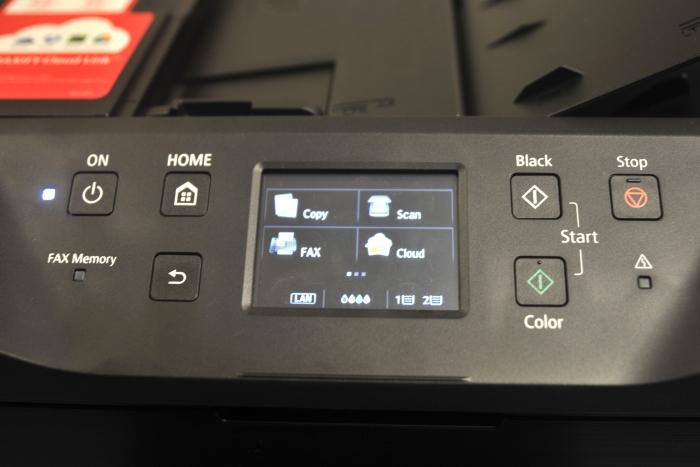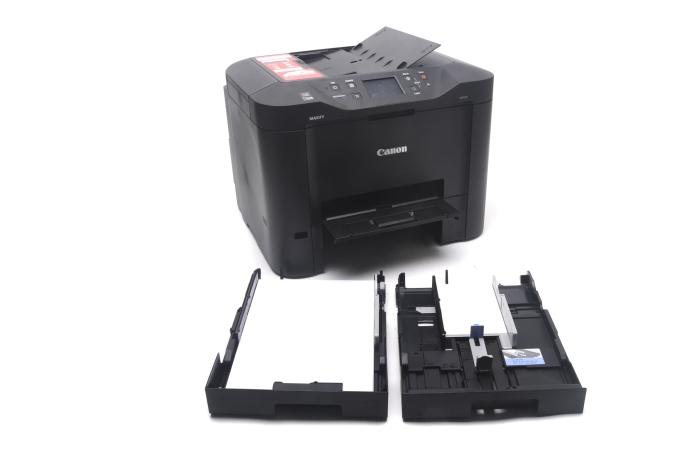
Canon Maxify MB5360 all-in-one inkjet printer
An inkjet printer that can supply low running costs for a small or home office
Pros
- 500-sheet paper capacity
- Efficient performer
- Decent speed
- Good for photos
Cons
- Touchscreen too small
- Text output could be better
-
Price
$ 349.00 (AUD)
The Canon Maxify MB5360 presents itself as a classy looking all-in-one printer with a compact footprint and plenty of versatility. You can use USB, Ethernet, or Wi-Fi to hook it up in your small (or home) office, or you can make use of Wi-Fi direct or Cloud services and apps to print from mobile devices and remote locations. The print technology is inkjet, the recommended output is 1000 pages per month, and the overall efficiency of the printer is quite high.
It's the type of printer that competes against models such as HP's Officejet line up of inkjet-based office printers, and while it may feel a little counterintuitive to think of an inkjet as an office workgroup printer, models such as the Maxify MB5360 offer a total cost of ownership that should be pleasing for workloads that aren't consistently heavy. That said, it does have a paper capacity of 500 sheets.
A dull finish ensures that there is only a minimum of plastic in the packaging of the printer, and that plastic is mostly restricted to the tape that holds the flappy bits in place during transportation. Compared to other recent printers that we've seen, which feature a glossy finish, the waste from the Canon's unpacking routine was minimal.
Four ink cartridges need to be installed (cyan, magenta, yellow, and black), with each having its own plastic wrap. They are fed one by one into a spring-loaded printhead. It's a similar set-up procedure to that of the HP Officejet 8620 that we also recently reviewed, except that the Canon didn't have a little 'engine room' light to assist the installation. The printer accepts XL versions of these cartridges (model name PGI-2600XL), which cost $50 for each colour, and $58 for black. The yield for each XL colour is 1500 pages, while for black it's 2500 pages.
This brings the cost per printed page to 2.3 cents for monochrome prints, and 12.2 cents for colour prints when you divide the cost by the yield. How many photos you print, and how colourful your document prints are in general will affect this figure; it's just a rough guide using the manufacturer's stated yields. Compared to something like the HP Officejet 8620, the costs are roughly the same, with the HP being a little more expensive for black prints at 2.7 cents per page, and a dash cheaper for colour at 12 cents per page. Pricing was obtained from Officeworks at the time of writing.
You get a two-tray set-up straight out of the box (each capable of accommodating 250 sheets), and there is also a built-in duplexer for printing on both sides of the paper. You can set it up on your wireless network using WPS or manual settings, or you can use Ethernet to connect it directly to your router. There is a 3in LCD touchscreen panel on the printer that you can use to enable these functions and set up the connection, but be warned that it can be hard to do things such as scrolling through settings due to the small screen area and the force that's needed to register a touch.

Drivers need to be acquired from Canon's site if you don't have an optical drive, and these will make sure that you can do all the fancy things; in addition to printing, you can scan documents directly from the printer to a computer on the network. The installation program's window continually grabbed the focus on our computer, meaning we couldn't work while the drivers installed themselves, but the install only lasted a few minutes. The end of the driver installation presents a service that asks for your permission to send your print job details to Canon. It's part of what Canon calls an 'Extended Survey Program' and you'll want to perhaps say no to it.
We printed mostly over our network (Ethernet and Wi-Fi) from Google Docs for our tests, as this is where we store most of our documents these days. Our main test print is a 47-page Word document with full pages of text that includes highlights, coloured text, underlines, and small print. The Maxify managed to print this document in 4min 1sec, with a minimum of spooling time, and taking only 22sec to get the first page out. In the middle of the run, it managed to print 14 pages within a one-minute span, showcasing a good amount of speed. Its overall average for this colour job comes out to just under 12 pages per minute (PPM), which is three pages shy of Canon's official 15ppm speed rating for colour jobs.
In duplex mode, the same 47-page document took 5min 57sec, with a first-page-out of 23sec. It pulled the paper back in swiftly for the purpose of reversing it, and we didn't experience paper jams from any of the duplex jobs that we undertook.
The engine in this printer is vigorous, spitting paper out with a force that can sometimes push the previous page towards the outskirts of the output tray. It was towards the 40th page in our test print at which point we thought the pages would be spilled onto the floor, with one particular page clinging to the tray by the barest of margins. Luckily, none of the pages fell off the tray, though one page did manage to get pushed in such a way that it ended up in the wrong order. It could do with a more vertical stop at the end of the output tray.
Print quality for text documents on plain paper isn't as crisp as we've seen from other business inkjets (or even on high-resolution paper), with standard and high quality prints showing plenty of feathering around most letters. That's not say that its quality is unacceptable, just that you might notice some errant strokes on certain letters (such as 's') if you start to look too closely at the output. More noticeable was the somewhat cut-off look of the letters at the start of sentences. Straight-edged capital letters such as 'L' and 'R' were printed with thinner than usual standing at the start of sentences, compared to other locations in our test document.
For photos, you can use the top paper tray, which accepts the loading of 4x6in glossy paper. Since there are two paper trays, you can leave the second tray full of plain A4 paper, and keep the glossies in the top tray if photo prints are a regular occurrence for you. To make for a smoother printing process, you'll want to register with the printer the type of paper you've loaded into each tray.

Importantly, this is a printer that can produce highly impressive results when photo output is needed. Out test photos printed with excellent detail and rich colouring. There wasn't any visible streaking or banding. A full page, A4 glossy print at high quality took 2min 20sec to emerge from the printer, with 4x6in photos taking 1min 4sec. It won't do borderless prints; that's a trick for a dedicated photo printer.
Scans and copies can be made directly from the printer's touchscreen interface to a computer on your network. An automatic document feeder (ADF) sits atop a scanner lid that can rise a little to accommodate the scanning of magazines and books. Double-sided documents can be printed in one pass through the ADF. A 12-page double-sided job was completed and saved as a PDF in 1min 16sec. Meanwhile, a 300dpi, A4 scan, saved as a JPEG, took under 20sec to complete. The quality of text scans, in particular, was good, while colour photo scans were average.
Canon doesn't supply recommended retail pricing for its products, but the most expensive price we found for this printer was $349 from Harvey Norman. Tax time deals from other stores, such as The Good Guys, had it for $259. If you can find it for the lower price, then it's a worthy device. Its output is reasonably quick, it has plenty of paper capacity, you can do 'Cloud' things with it such as hook it up to your Google Print account, and, of course, it can scan, copy, and fax, too. Running costs are low, and this includes energy consumption, which peaked at 27W during print jobs.
Related printer articles
Brand Post

Most Popular Reviews
- 1 Dell U3223QE review: A winning debut for an IPS Black monitor
- 2 HP Spectre x360 16 review: The right 2-in-1 at the wrong time
- 3 Acer K242HYL review: An affordable monitor for any occasion
- 4 GeForce Now review: You bring the games, Nvidia streams the hardware
- 5 Asus ProArt PA279CV monitor review: The go-to for content creators on a budget
Latest News Articles
- Want to go watch the WWDC keynote at Apple Park? Here’s how to apply
- Apple to support ‘passwordless’ iPhone logins on Android phones and PCs
- If you downloaded iOS 9 on an iPhone 4s, you may be entitled to a refund check
- Best wireless headphones
- An intrepid YouTuber made his own 5K Studio Display for just US$600
Resources
Macworld
What's new, plus best mac-related tips
and tricks

Business Centre
The latest business news, reviews, features and whitepapers

Videos
Watch our video news and reviews from around the world

Guides
Comprehensive buying guides, features, and step-by-step articles

PCW Evaluation Team
Pedro Peixoto
Aruba Instant On AP11D

Set up is effortless.
Cate Bacon
Aruba Instant On AP11D

The strength of the Aruba Instant On AP11D is that the design and feature set support the modern, flexible, and mobile way of working.
Dr Prabigya Shiwakoti
Aruba Instant On AP11D

Aruba backs the AP11D up with a two-year warranty and 24/7 phone support.
Tom Pope
Dynabook Portégé X30L-G

Ultimately this laptop has achieved everything I would hope for in a laptop for work, while fitting that into a form factor and weight that is remarkable.
Tom Sellers
MSI P65

This smart laptop was enjoyable to use and great to work on – creating content was super simple.
Lolita Wang
MSI GT76

It really doesn’t get more “gaming laptop” than this.
Featured Content
- Which Lenovo Laptop Should I Buy?
- Every TV in Samsung's 2022 line-up: OLED, Neo QLED and more!
- Top 10 best Android and Apple phones for under $600
- Everything you need to know about Smart TVs
- What's the difference between an Intel Core i3, i5 and i7?
- Laser vs. inkjet printers: which is better?










